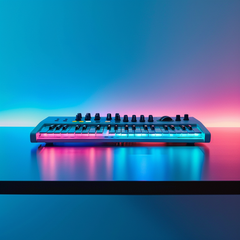How to recognize in 10 Seconds if a Sample fits your Track
One of the most time-consuming tasks in music production is auditioning samples. With thousands of options in your library, it’s easy to lose hours testing sounds to see if they fit your track. However, when working in genres like Tech House and Minimal, efficiency is key. Every sound plays a crucial role, and knowing quickly whether a sample fits can save you valuable time and help you maintain your creative flow.
Here’s a detailed guide to determining in 10 seconds or less whether a sample deserves a place in your track.
1. Start with Key Compatibility
The first thing to check is whether the sample is in the same key as your track. If a melodic or harmonic element is out of tune, it can clash with the rest of your composition and ruin the vibe.
- How to Check: Load the sample into your DAW and play it along with your track’s main harmonic elements (e.g., bassline, chords, or melody). If your DAW shows the key of the sample, compare it with your track’s key. If the sample feels off but still intriguing, pitch-shift it up or down a few semitones to see if it locks in better.
- Why This Matters: In Tech House and Minimal, even small harmonic clashes can disrupt the clean and hypnotic nature of the genre.
Example: A vocal loop in a dissonant key might sound jarring, but pitching it slightly could transform it into a perfect fit.
2. Analyze the Texture
The texture of a sample—its tonal quality, warmth, and sharpness—plays a significant role in whether it will complement your track. Minimal and Tech House rely heavily on clean, distinct textures to create a sense of space and balance.
- How to Check: Ask yourself: Is the sample too harsh, bright, or dull compared to the rest of your elements? Play the sample in your mix and evaluate whether it enhances or detracts from the overall sound.
- Why This Matters: Overly harsh samples might overpower the mix, while dull ones could get lost. The right texture adds depth and intrigue without cluttering.
3. Evaluate the Timing
Timing is everything in electronic music, particularly in groove-heavy genres like Tech House. A sample that doesn’t align rhythmically with your track can feel awkward and out of place.
- How to Check: Drag the sample into your DAW and play it without adjusting its timing. If it naturally syncs to your beat or can easily be quantized, it’s a good fit. If not, it might require too much editing to be worth the effort.
- Why This Matters: Samples that flow with your groove maintain the momentum of your track and reduce the time spent editing.
Pro Tip: If your sample has swing or shuffle, match it to your track’s rhythm to create a cohesive groove.
4. Compare the Frequency Range
In Minimal and Tech House, every frequency range has a purpose. Overlapping frequencies can muddy the mix, while gaps in the spectrum can leave your track feeling empty.
- How to Check: Use a spectrum analyzer to identify where the sample sits in the frequency range. If it fills a gap without competing with other elements, it’s likely a good choice. For instance, a sharp percussion hit might add brightness without interfering with your kick or bass.
- Why This Matters: Maintaining clarity in your mix is essential for the polished, club-ready sound that defines these genres.
5. Match the Energy
The energy of a sample should align with your track’s overall vibe. Minimal tracks often have subtle energy that builds gradually, while Tech House leans on driving, rhythmic momentum.
- How to Check: Play the sample over the most energetic section of your track. Does it elevate the energy, or does it feel too aggressive or subdued?
- Why This Matters: A sample that doesn’t match your track’s energy can create an imbalance, making the track feel disconnected or inconsistent.
6. Focus on the Groove
Groove is the foundation of Tech House, and every sample should support it. Whether it’s a percussive hit or a vocal snippet, the sample should contribute to the rhythmic flow.
- How to Check: Drop the sample into a drum or percussion loop. Does it complement the kick and bassline, or does it disrupt the flow? If the sample adds to the groove, it’s a winner.
- Why This Matters: A well-placed sample can take your groove to the next level, keeping listeners hooked.
7. Look for Uniqueness
Tech House and Minimal thrive on originality. Generic samples might fill a gap temporarily, but they won’t make your track stand out.
- How to Check: Ask yourself: Does this sample bring something fresh to the table? Unique sounds—such as textured percussion or creative vocal chops—can add character to your production.
- Why This Matters: In competitive genres, originality helps your track leave a lasting impression.
8. Assess Processing Potential
Sometimes, a sample might not fit perfectly as-is but has potential with some processing. Knowing what’s workable and what’s not is key.
- How to Check: Consider how easily you can manipulate the sample with EQ, reverb, delay, or distortion. If you see clear potential for improvement, it’s worth keeping.
- Why This Matters: Processing can turn a mediocre sample into a standout element with the right approach.
9. Trust Your Instincts
Your gut reaction is often the best indicator of whether a sample fits. Overanalyzing can lead to indecision, so trust your first impression.
- How to Check: Play the sample. If it feels wrong or doesn’t excite you, move on. If it sparks inspiration, it’s likely a good fit.
- Why This Matters: Overthinking kills creativity. Trust your ears and instincts to make quick decisions.
10. Always Test in Context
A sample that sounds great in isolation might not work in your mix. Always audition it alongside your other track elements.
- How to Check: Play the sample within the full context of your track. Does it enhance the mix, or does it feel out of place?
- Why This Matters: Context is everything. A sample that fits perfectly with your track creates cohesion and flow.
Pro Tip: Build a Focused Sample Library
To save even more time, curate a library of high-quality samples tailored to your style. Using genre-specific sample packs, like those designed for Tech House and Minimal, ensures you’re starting with sounds that already fit your aesthetic.
Conclusion: With these techniques, you’ll be able to quickly identify whether a sample fits your track, keeping your workflow fast and your creativity flowing. Start implementing these tips today and watch your productivity soar!









